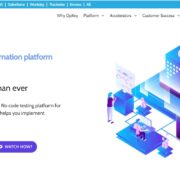Image Source:- Pixabay
Software testing is an important part of the software cycle. It is where businesses come to know whether their product is performing as expected or not. Nowadays, manual testing has been replaced by cloud-based automation testing.
Cloud-based automated testing tools have made the task of testing software to check for performance, workability, and bug detection relatively quick and simple. Businesses can use cloud testing for functional, non-functional, and ability testing of the software. This relieves the human resources, efforts, time, and costs spent on manual software testing methods. Here’s a detailed look at the benefits of cloud-based automation testing.
Benefits of Cloud-Based Automation Software Testing
1.) Reduce the Use of Enterprise
The enterprise can use computing resources such as server performance time and cloud storage. There will be no need for the enterprise to interact with the cloud service provider once it has signed up for the desired services.
2.) Allow for Broad Network Access
Cloud interaction and device communication are all supported by cloud network services. As a result, large enterprises that use various IoT devices can interconnect and access devices via cloud networks.
3.) Support Resource Pooling
Public computing resources are distributed and accessed by many consumers. This resource sharing allows businesses to leverage processing, storage, memory, and other resources with a single automation testing software.
4.) Rapid Elasticity
Computing resources can be provisioned to enterprises for nonce supported requirements. The resources are available on a pay-as-you-go basis. It makes it easier for businesses to install them or cancel them when no longer required.
5.) Enhanced Virtual Infrastructure and Testing Environments
Because of the flexibility of the cloud, businesses can use testing from anywhere in the world. All they need is a good internet connection.
6.) Budget-Friendly
Cloud-based tools have lower hardware requirements. They do not need expensive per-seat licensing fees. This implies that the cost and depreciation costs are kept to the least. Cloud-based tools allow a high degree of reusability of test components.
They are also ideal for load and performance testing. Pay as you go allows you to scale up and down your cloud usage based on your testing requirements.
7.) Testing Is More Efficient
Automation tools provide benefits such as increased productivity and shorter test cycles. Cloud-based automation tools provide the added benefits of quick setup and power deployment. Unlike traditional agencies, they do not need a lengthy discovery and installation process.
Testing can begin right now from anywhere in the world. Upgrades to the software are seamless, with little to no downtime. Faster testing reduces its promotion time, giving businesses a significant competitive advantage.
8.) Reduction in IT Management Effort
Cloud-based tools end many IT management tasks inherent in traditional tools. These include installation, licensing, adding/replacing users, and other tasks. With less IT management to worry about, employees can focus on core activities. This makes a difference in their bottom line.
Cloud-based testing tools are becoming the norm in performance and cargo testing. This provides far greater scaling capacity than traditional tools and the total payment value you use.
Furthermore, cloud-based solutions enable high reusability of the components used in test scenarios. Testers can use the automation testing platform’s features to determine how software performs on various devices. Be it a desktop, tablet, or mobile services application.
9.) Provide Constant Use of Shared Resources
Cloud-based testing allows users to access resources 24 hours a day, seven days a week. They can accommodate client requests because they have access 24 hours a day, seven days a week. Testers can detect bugs and errors early in the software development lifecycle.
Also, quality assurance teams in various time zones can access the resources whenever they want. Thus, cloud-based environments provide efficient test coverage in a brief period. Groups registered on the platform can immediately log in and begin testing. Cloud offers the benefit of resource sharing at a low capital cost.
10.) Backup Recovery
Traditional backup recovery solutions need costly upgrades and upkeep. Furthermore, recovering critical data may be impossible in a hardware failure. Cloud software testing provides an easy way to retrieve all assets, often with the click of a button.
Moreover, the information is stored on many servers. The opposite servers will restore the data if one server fails. As a result, cloud testing ensures the long-term viability of your operations. The technology also allows businesses to prepare for audits by retrieving historical data.
11.) Testing in Parallel
At the outset, we mentioned parallel testing. Let’s go over it a little more closely now.
In an ideal world, software test targets would include a variety of browsers, operating systems, and devices. When you use the cloud, you will perform parallel tests on all those environments. You won’t follow a predetermined sequence.
This saves testing time, making valuable cloud testing in agile and CI methodologies. Furthermore, the cloud enables businesses to scale the elasticity and coverage of both mobile and web platforms.
12.) Variables in the Environment
The enterprise can emulate the “end-user” environment with cloud-based software testing. This can be done by customizing it to their needs. Teams can run performance and cargo testing scenarios in various combinations and permutations. This helps in saving time and money.
Creating a user-centric environment necessitates an enormous investment in an offline grid, which is not possible for every company. Furthermore, hosting and managing tests consumes a significant part of the investment. Cloud-based testing can help reduce costs while also addressing these limitations.
13.) Helping in Increasing Collaboration
Cloud-based automation tools enable teams in different locations to collaborate efficiently. Testers can fast test from various sites and access test notes globally without uploading or downloading them.
Final Thoughts
With the advantages mentioned above, we can see that cloud-based automation testing is definitely more beneficial than traditional testing. Businesses can get an improved ROI, save time and resources, and enhance their output with cloud-based testing.
Deploying cloud-based automation testing at the earliest should be a priority if you want to see accelerated, positive results at your enterprise. So when are you implementing cloud-based automated software testing at your workplace?




